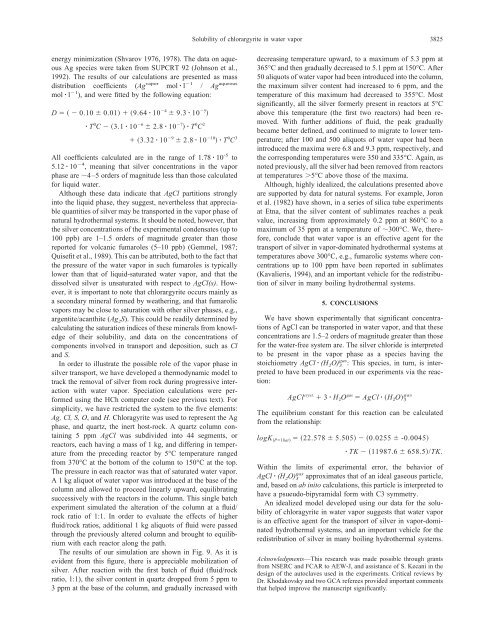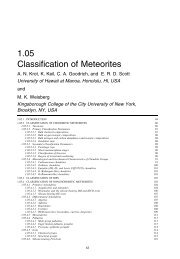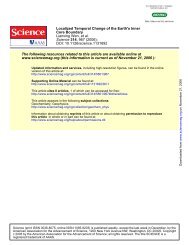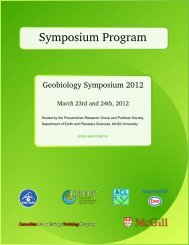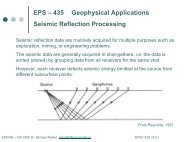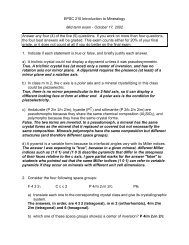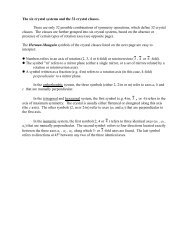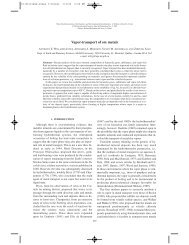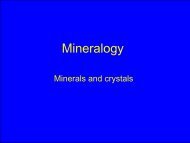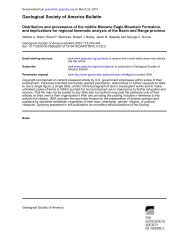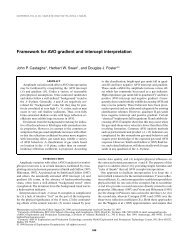Solubility of chlorargyrite (AgCl) in water vapor at elevated ...
Solubility of chlorargyrite (AgCl) in water vapor at elevated ...
Solubility of chlorargyrite (AgCl) in water vapor at elevated ...
You also want an ePaper? Increase the reach of your titles
YUMPU automatically turns print PDFs into web optimized ePapers that Google loves.
<strong>Solubility</strong> <strong>of</strong> <strong>chlorargyrite</strong> <strong>in</strong> <strong>w<strong>at</strong>er</strong> <strong>vapor</strong><br />
3825<br />
energy m<strong>in</strong>imiz<strong>at</strong>ion (Shvarov 1976, 1978). The d<strong>at</strong>a on aqueous<br />
Ag species were taken from SUPCRT 92 (Johnson et al.,<br />
1992). The results <strong>of</strong> our calcul<strong>at</strong>ions are presented as mass<br />
distribution coefficients (Ag <strong>vapor</strong> mol l 1 / Ag aqueous<br />
mol l 1 ), and were fitted by the follow<strong>in</strong>g equ<strong>at</strong>ion:<br />
D 0.10 0.01 9.64 10 4 9.3 10 5 <br />
T 0 C 3.1 10 6 2.8 10 7 T 0 C 2<br />
3.32 10 9 2.8 10 10 T 0 C 3<br />
All coefficients calcul<strong>at</strong>ed are <strong>in</strong> the range <strong>of</strong> 1.78 10 -5 to<br />
5.12 10 4 , mean<strong>in</strong>g th<strong>at</strong> silver concentr<strong>at</strong>ions <strong>in</strong> the <strong>vapor</strong><br />
phase are 4–5 orders <strong>of</strong> magnitude less than those calcul<strong>at</strong>ed<br />
for liquid <strong>w<strong>at</strong>er</strong>.<br />
Although these d<strong>at</strong>a <strong>in</strong>dic<strong>at</strong>e th<strong>at</strong> <strong>AgCl</strong> partitions strongly<br />
<strong>in</strong>to the liquid phase, they suggest, nevertheless th<strong>at</strong> appreciable<br />
quantities <strong>of</strong> silver may be transported <strong>in</strong> the <strong>vapor</strong> phase <strong>of</strong><br />
n<strong>at</strong>ural hydrothermal systems. It should be noted, however, th<strong>at</strong><br />
the silver concentr<strong>at</strong>ions <strong>of</strong> the experimental condens<strong>at</strong>es (up to<br />
100 ppb) are 1–1.5 orders <strong>of</strong> magnitude gre<strong>at</strong>er than those<br />
reported for volcanic fumaroles (5–10 ppb) (Gemmel, 1987;<br />
Quisefit et al., 1989). This can be <strong>at</strong>tributed, both to the fact th<strong>at</strong><br />
the pressure <strong>of</strong> the <strong>w<strong>at</strong>er</strong> <strong>vapor</strong> <strong>in</strong> such fumaroles is typically<br />
lower than th<strong>at</strong> <strong>of</strong> liquid-s<strong>at</strong>ur<strong>at</strong>ed <strong>w<strong>at</strong>er</strong> <strong>vapor</strong>, and th<strong>at</strong> the<br />
dissolved silver is uns<strong>at</strong>ur<strong>at</strong>ed with respect to <strong>AgCl</strong>(s). However,<br />
it is important to note th<strong>at</strong> <strong>chlorargyrite</strong> occurs ma<strong>in</strong>ly as<br />
a secondary m<strong>in</strong>eral formed by we<strong>at</strong>her<strong>in</strong>g, and th<strong>at</strong> fumarolic<br />
<strong>vapor</strong>s may be close to s<strong>at</strong>ur<strong>at</strong>ion with other silver phases, e.g.,<br />
argentite/acanthite (Ag 2 S). This could be readily determ<strong>in</strong>ed by<br />
calcul<strong>at</strong><strong>in</strong>g the s<strong>at</strong>ur<strong>at</strong>ion <strong>in</strong>dices <strong>of</strong> these m<strong>in</strong>erals from knowledge<br />
<strong>of</strong> their solubility, and d<strong>at</strong>a on the concentr<strong>at</strong>ions <strong>of</strong><br />
components <strong>in</strong>volved <strong>in</strong> transport and deposition, such as Cl<br />
and S.<br />
In order to illustr<strong>at</strong>e the possible role <strong>of</strong> the <strong>vapor</strong> phase <strong>in</strong><br />
silver transport, we have developed a thermodynamic model to<br />
track the removal <strong>of</strong> silver from rock dur<strong>in</strong>g progressive <strong>in</strong>teraction<br />
with <strong>w<strong>at</strong>er</strong> <strong>vapor</strong>. Speci<strong>at</strong>ion calcul<strong>at</strong>ions were performed<br />
us<strong>in</strong>g the HCh computer code (see previous text). For<br />
simplicity, we have restricted the system to the five elements:<br />
Ag, Cl, S, O, and H. Chloragyrite was used to represent the Ag<br />
phase, and quartz, the <strong>in</strong>ert host-rock. A quartz column conta<strong>in</strong><strong>in</strong>g<br />
5 ppm <strong>AgCl</strong> was subdivided <strong>in</strong>to 44 segments, or<br />
reactors, each hav<strong>in</strong>g a mass <strong>of</strong> 1 kg, and differ<strong>in</strong>g <strong>in</strong> temper<strong>at</strong>ure<br />
from the preced<strong>in</strong>g reactor by 5°C temper<strong>at</strong>ure ranged<br />
from 370°C <strong>at</strong> the bottom <strong>of</strong> the column to 150°C <strong>at</strong> the top.<br />
The pressure <strong>in</strong> each reactor was th<strong>at</strong> <strong>of</strong> s<strong>at</strong>ur<strong>at</strong>ed <strong>w<strong>at</strong>er</strong> <strong>vapor</strong>.<br />
A 1 kg aliquot <strong>of</strong> <strong>w<strong>at</strong>er</strong> <strong>vapor</strong> was <strong>in</strong>troduced <strong>at</strong> the base <strong>of</strong> the<br />
column and allowed to proceed l<strong>in</strong>early upward, equilibr<strong>at</strong><strong>in</strong>g<br />
successively with the reactors <strong>in</strong> the column. This s<strong>in</strong>gle b<strong>at</strong>ch<br />
experiment simul<strong>at</strong>ed the alter<strong>at</strong>ion <strong>of</strong> the column <strong>at</strong> a fluid/<br />
rock r<strong>at</strong>io <strong>of</strong> 1:1. In order to evalu<strong>at</strong>e the effects <strong>of</strong> higher<br />
fluid/rock r<strong>at</strong>ios, additional 1 kg aliquots <strong>of</strong> fluid were passed<br />
through the previously altered column and brought to equilibrium<br />
with each reactor along the p<strong>at</strong>h.<br />
The results <strong>of</strong> our simul<strong>at</strong>ion are shown <strong>in</strong> Fig. 9. As it is<br />
evident from this figure, there is appreciable mobiliz<strong>at</strong>ion <strong>of</strong><br />
silver. After reaction with the first b<strong>at</strong>ch <strong>of</strong> fluid (fluid/rock<br />
r<strong>at</strong>io, 1:1), the silver content <strong>in</strong> quartz dropped from 5 ppm to<br />
3 ppm <strong>at</strong> the base <strong>of</strong> the column, and gradually <strong>in</strong>creased with<br />
decreas<strong>in</strong>g temper<strong>at</strong>ure upward, to a maximum <strong>of</strong> 5.3 ppm <strong>at</strong><br />
365°C and then gradually decreased to 5.1 ppm <strong>at</strong> 150°C. After<br />
50 aliquots <strong>of</strong> <strong>w<strong>at</strong>er</strong> <strong>vapor</strong> had been <strong>in</strong>troduced <strong>in</strong>to the column,<br />
the maximum silver content had <strong>in</strong>creased to 6 ppm, and the<br />
temper<strong>at</strong>ure <strong>of</strong> this maximum had decreased to 355°C. Most<br />
significantly, all the silver formerly present <strong>in</strong> reactors <strong>at</strong> 5°C<br />
above this temper<strong>at</strong>ure (the first two reactors) had been removed.<br />
With further additions <strong>of</strong> fluid, the peak gradually<br />
became better def<strong>in</strong>ed, and cont<strong>in</strong>ued to migr<strong>at</strong>e to lower temper<strong>at</strong>ure;<br />
after 100 and 500 aliquots <strong>of</strong> <strong>w<strong>at</strong>er</strong> <strong>vapor</strong> had been<br />
<strong>in</strong>troduced the maxima were 6.8 and 9.3 ppm, respectively, and<br />
the correspond<strong>in</strong>g temper<strong>at</strong>ures were 350 and 335°C. Aga<strong>in</strong>, as<br />
noted previously, all the silver had been removed from reactors<br />
<strong>at</strong> temper<strong>at</strong>ures 5°C above those <strong>of</strong> the maxima.<br />
Although, highly idealized, the calcul<strong>at</strong>ions presented above<br />
are supported by d<strong>at</strong>a for n<strong>at</strong>ural systems. For example, Joron<br />
et al. (1982) have shown, <strong>in</strong> a series <strong>of</strong> silica tube experiments<br />
<strong>at</strong> Etna, th<strong>at</strong> the silver content <strong>of</strong> sublim<strong>at</strong>es reaches a peak<br />
value, <strong>in</strong>creas<strong>in</strong>g from approxim<strong>at</strong>ely 0.2 ppm <strong>at</strong> 860°C to a<br />
maximum <strong>of</strong> 35 ppm <strong>at</strong> a temper<strong>at</strong>ure <strong>of</strong> 300°C. We, therefore,<br />
conclude th<strong>at</strong> <strong>w<strong>at</strong>er</strong> <strong>vapor</strong> is an effective agent for the<br />
transport <strong>of</strong> silver <strong>in</strong> <strong>vapor</strong>-dom<strong>in</strong><strong>at</strong>ed hydrothermal systems <strong>at</strong><br />
temper<strong>at</strong>ures above 300°C, e.g., fumarolic systems where concentr<strong>at</strong>ions<br />
up to 100 ppm have been reported <strong>in</strong> sublim<strong>at</strong>es<br />
(Kavalieris, 1994), and an important vehicle for the redistribution<br />
<strong>of</strong> silver <strong>in</strong> many boil<strong>in</strong>g hydrothermal systems.<br />
5. CONCLUSIONS<br />
We have shown experimentally th<strong>at</strong> significant concentr<strong>at</strong>ions<br />
<strong>of</strong> <strong>AgCl</strong> can be transported <strong>in</strong> <strong>w<strong>at</strong>er</strong> <strong>vapor</strong>, and th<strong>at</strong> these<br />
concentr<strong>at</strong>ions are 1.5–2 orders <strong>of</strong> magnitude gre<strong>at</strong>er than those<br />
for the <strong>w<strong>at</strong>er</strong>-free system are. The silver chloride is <strong>in</strong>terpreted<br />
to be present <strong>in</strong> the <strong>vapor</strong> phase as a species hav<strong>in</strong>g the<br />
stoichiometry <strong>AgCl</strong> (H 2 O) 3 gas : This species, <strong>in</strong> turn, is <strong>in</strong>terpreted<br />
to have been produced <strong>in</strong> our experiments via the reaction:<br />
<strong>AgCl</strong> cryst. 3 H 2 O gas <strong>AgCl</strong> H 2 O 3<br />
gas<br />
The equilibrium constant for this reaction can be calcul<strong>at</strong>ed<br />
from the rel<strong>at</strong>ionship:<br />
logK P1bar 22.578 5.505 0.0255 -0.0045<br />
TK 11987.6 658.5/TK.<br />
With<strong>in</strong> the limits <strong>of</strong> experimental error, the behavior <strong>of</strong><br />
<strong>AgCl</strong> (H 2 O) 3 gas approxim<strong>at</strong>es th<strong>at</strong> <strong>of</strong> an ideal gaseous particle,<br />
and, based on ab <strong>in</strong>ito calcul<strong>at</strong>ions, this particle is <strong>in</strong>terpreted to<br />
have a psueudo-bipyramidal form with C3 symmetry.<br />
An idealized model developed us<strong>in</strong>g our d<strong>at</strong>a for the solubility<br />
<strong>of</strong> chloragyrite <strong>in</strong> <strong>w<strong>at</strong>er</strong> <strong>vapor</strong> suggests th<strong>at</strong> <strong>w<strong>at</strong>er</strong> <strong>vapor</strong><br />
is an effective agent for the transport <strong>of</strong> silver <strong>in</strong> <strong>vapor</strong>-dom<strong>in</strong><strong>at</strong>ed<br />
hydrothermal systems, and an important vehicle for the<br />
redistribution <strong>of</strong> silver <strong>in</strong> many boil<strong>in</strong>g hydrothermal systems.<br />
Acknowledgments—This research was made possible through grants<br />
from NSERC and FCAR to AEW-J, and assistance <strong>of</strong> S. Kecani <strong>in</strong> the<br />
design <strong>of</strong> the autoclaves used <strong>in</strong> the experiments. Critical reviews by<br />
Dr. Khodakovsky and two GCA referees provided important comments<br />
th<strong>at</strong> helped improve the manuscript significantly.


